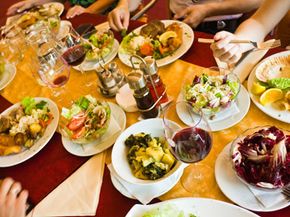When you picture the perfect dinner party, you probably think of a dozen close friends gathered around the table, enjoying a meal, sipping wine and engaging in interesting conversation. What you don't think about is those dinner parties that go wrong, with burnt food, guests who have nothing to talk about and a harried host busy sweating in the kitchen. The difference between these two scenarios is the result of proper planning. A bit of preparation before the big day is the key is to ensuring your dinner party will be an event that your guests will rave about.
While there are countless ways for friends to get together, a dinner party is one of the most intimate types of gatherings. Because the whole point of the dinner party is sitting together for a meal, there's much more opportunity to talk as a group than at other types of parties. Not only is everyone in one spot at the same time, but things tend to be quieter and calmer than at a traditional party. Many people also feel that a dinner party allows the host to add a personal touch to the event, especially compared to having the party at an event hall or restaurant. In addition, guests will appreciate the extra effort that goes into the event, and the host will enjoy a chance to show off a lovely house and a bit of home cooking.
Advertisement
For the first-time host, there are many factors to consider when it comes to planning a successful dinner party. Not only do you need to think about what type of party to hold, but you must evaluate the guest list, plan the menu and manage to pull off the entire event while still finding time to enjoy yourself. Even if you've hosted dinner parties in the past, there are many ways to make your next event easier and more fun for both you and your guests.
To get ideas for unique dinner party themes and finding the right time to hold your event, read on to the next section.
Advertisement

